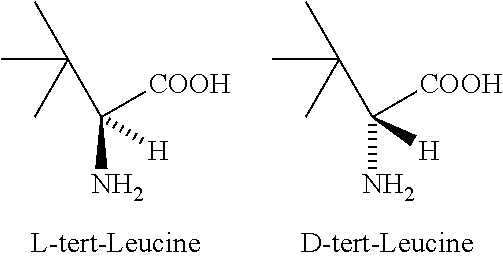Process for the preparation of enantiomerically pure tert-leucine
a technology of tert-leucine and enantiomer, which is applied in the field of process for the preparation of enantiomerically pure land dtert-leucine, can solve the problems of difficult to obtain free tert-leucine from its salts, unsatisfactory industrial production methods, and uneconomical approaches
- Summary
- Abstract
- Description
- Claims
- Application Information
AI Technical Summary
Problems solved by technology
Method used
Image
Examples
example 1
[0035](DL)-tert-Leucine (15 g, 0.1145 mol) was dissolved in water (180 mL). To the solution was added dibenzoyl-d-tartaric acid monohydrate (21.5 g, 0.057 mol) and stirred for 24 hours at 28° C. (±3). The reaction mixture was filtered to collect L-tert-leucine dibenzoyl-d-tartrate salt. The filtrate was reserved for isolating D-tert-leucine later. The tartrate salt was added to water (150 mL) followed by concentrated sulphuric acid (3 mL) and stirred for 4 hours. Liberated dibenzoyl-d-tartaric acid was collected and dried (19.8 g, 92% yield). The filtrate was washed with diisopropyl ether (50 mL) to remove any traces of dibenzoyl-d-tartaric acid, cooled to 5° C. and treated with a saturated solution of barium hydroxide till the pH was neutral. It was filtered to remove the precipitated barium sulphate. The filtrate was concentrated under reduced pressure to remove all the solvent. The residue obtained was stirred with acetone (15 mL×2), filtered and dried to obtain colorless solid L...
example 2
[0037]A mixture of L-tert-leucine.dibenzoyl-d-tartrate salt (27 g) as obtained in example-1, water (150 mL) and concentrated hydrochloric acid (50 mL) was stirred for 12 hours. The liberated dibenzoyl-d-tartaric acid was filtered and dried (20 g). The filtrate was concentrated under reduced pressure to remove all the solvent. The residue obtained was stirred with acetone (15 ml×2), filtered and dried to obtain colorless solid of L-tert-leucine hydrochloride salt. It was suspended in toluene (50 mL) and epichlorohydrin (5.8 g) was added. The reaction mixture was stirred till the pH was neutral. It was filtered, the solid obtained was stirred with acetone (15 ml×2) and again filtered to obtain L-tert-leucine (5.6 g, 75% yield, 98.5% chemical purity, 99.9% chiral purity).
example 3
[0038]Ammonium hydroxide (50 mL, 30%) solution was placed in an autoclave and D-tert-leucine (5 g) was added. Autoclave was closed and the contents were heated to 85° C. under stirring for 12 hours. After cooling the solution was transferred and concentrated under vacuum at 55° C. The solid residue obtained was stirred with acetone (20 mL), filtered and dried to obtain DL-tert-leucine (4.6 g, 92% yield, L-isomer: 42%, D-isomer: 58%)
PUM
| Property | Measurement | Unit |
|---|---|---|
| chiral purity | aaaaa | aaaaa |
| chiral purity | aaaaa | aaaaa |
| chiral purity | aaaaa | aaaaa |
Abstract
Description
Claims
Application Information
 Login to View More
Login to View More - R&D
- Intellectual Property
- Life Sciences
- Materials
- Tech Scout
- Unparalleled Data Quality
- Higher Quality Content
- 60% Fewer Hallucinations
Browse by: Latest US Patents, China's latest patents, Technical Efficacy Thesaurus, Application Domain, Technology Topic, Popular Technical Reports.
© 2025 PatSnap. All rights reserved.Legal|Privacy policy|Modern Slavery Act Transparency Statement|Sitemap|About US| Contact US: help@patsnap.com

